Grad
| Target Type: Intrusion-hosted gold |
| Location: Northwest Territories, Canada |

Overview
The Grad and OGRE Properties are in the Tombstone Gold Belt in the Northwest Territories (NWT) in an area that has experienced little historical exploration activity. In June of 2024, the Government of NWT and Sahtu Dene First Nation opened the area to mineral exploration following the amendment of the Land Use Plan for the region, designating this area for industrial development.
Rackla had previously identified the area as having excellent potential for Reduced Intrusion-related Gold System (RIRGS) having researched the government Regional Geochemical Survey (RGS) data and NWT Geoscience Office (NTGO) Mineral Assessment Potential studies performed when assessing the area for the Land Use Plan. The area stood out for the high gold and bismuth in stream sediment samples associated with mid-Cretaceous intrusions – known to be the host units for RIRGS deposits in Yukon and Alaska.
Rackla conducted a first pass, grassroots exploration program early July of 2024 consisting of stream sediment sampling and prospecting and the crew was very impressed with the intensity of alteration in the contact aureole around the intrusions and noticeably high concentration of veining and sulphide mineralization within the intrusions. This prompted the company to stake the OGRE and Grad properties, each measuring 2,000 hectares at that time. The Grad property was subsequently expanded to 5,525 hectares (Figure 1).

During the claim staking in 2024 prospecting crews continued to evaluate the area. It was during this time the BiTe Showing was identified. Two samples collected at BiTe returned very significant results. Sample ST220966 returned 92.40 g/t Au, 2.17% Bi, 1,250 ppm Te; Sample ST220965 returned 15.85 g/t Au, 0.97% Bi and 331 ppm Te. These results were followed up with more sampling and a continuous chip channel sample of the showing returned 1.8 g/t Au over 38 meters and talus sampling defined a 550 meter wide gold-bismuth anomaly.
The BiTe Showing occurs at the southern edge of the North Nahanni Pluton, a Mid-Cretaceous, Mayo Suite, quartz monzonite felsic intrusion. The Pluton measures 1.8 by 1 km. Sixteen hundred metres to the south, a second previously unidentified, intrusion was discovered by the prospecting crews. Both intrusions have a sizable, intensely altered, contact aureole expressed as hornfelsed and iron stained gossanous Earn Group sediments. Talus-fine samples were collected in the valleys to the north, east and south of the North Nahanni Pluton (Figure 2). These samples returned anomalous gold, bismuth and tellurium values on the eastern and southern portion of the intrusion and highlighted the BiTe Showing with a 550 meter wide anomaly which returned 6 samples greater than 1 g/t gold, including one sample that contained 7.5 g/t gold and bismuth values up to 2930 ppm (Figure 3).


The BiTe Showing is identified by intense quartz-sulfide veining observed in the cliffs of the North Nahanni Pluton and in float in the scree slopes. The preliminary observations indicate the Pluton to be a multiphase intrusion with stockwork veining in the upper carapace. Over 50% of samples from intrusion returned anomalous results of gold. Abundant quartz-tourmaline veining and zones of disseminated bismuth+tellurium sulfides were also observed at the BiTe cliff. The geological setting, vein density, mineral association and gold content indicate that the BiTe Showing is a Reduced Intrusion-Related Gold System. The continuous chip channel sample above the talus line returned 1.8 g/t Au over 38 meters (Figure 4). The channel started at the scree-outcrop interface and ended at a steep cliff face to the north. Both ends of the channel remain open, notably the northern extent ended in 5.3 g/t Au over 6 meters. Selective chip channel sampling ranging between 1 to 2.5 meters in width were collected from within the area and highlighted arial extent of the gold mineralization, with results up to 1.1 g/t Au over 2.5 meters and 1.0 g/t Au over 1.5 meters.

Mapping and prospecting extended the silica-sericite alteration zone to the base of the scree slope, where two grab samples returned 11.4 g/t Au and 1.8 g/t Au. Outside of the silica-sericite alteration zone, quartz-tourmaline sheeted and stockwork veining returned up to 6.8 g/t Au.
2025 Work Program Results and Summary
Based on the initial surface results, a maiden drill program was completed at the BiTe Zone, comprising approximately 4,500 m in 10 drill holes. The program tested beneath the high-grade BiTe showing discovered in 2024, as well as extensions to the north and west, and the intrusive–sedimentary contact zone to the south of the BiTe showing, with drilling continuing well into the intrusive to the south.
The program sucuesfully tested a compelling geoligcal model but did not return continuity of the surface mineralization and failed to intersect significant gold mineralization, indicating that the system is more complex and likely requires a diffrent targeting approach. The 2025 program represents the maiden drill testing on the property, and management believes it was the most logical first step to evaluate the high-grade surface results collected from the steep cliff-face exposure identified during the 2024 field season.
Rackla is encouraged that the Reduced Intrusion-Related Gold System (RIRGS) model appears to be the correct model for the Grad property, as evidenced by the strong correlation between gold, bismuth, and tellurium. However, only minor, isolated gold values were returned from the drilling, with the best result being Hole G25-009, which returned 10.5 m grading 2.56 g/t Au (see table below).
BiTe Zone Table of Drill Results
| Hole | From (m) | To (m) | Interval (m) | Gold (g/t) | Bismuth (ppm) | Tellurium (ppm) | Tungsten (ppm) |
| G25-001 | 57.95 | 59.00 | 1.05 | 1.72 | 3510 | 298.0 | 21 |
| 59.00 | 60.30 | 1.30 | 0.55 | 1300 | 100.5 | 75.4 | |
| 64.30 | 65.00 | 0.70 | 0.54 | 378 | 30.5 | 18.4 | |
| 87.50 | 89.00 | 1.50 | 1.00 | 151 | 16.0 | 590 | |
| 98.00 | 99.50 | 1.50 | 0.84 | 819 | 33.4 | 650 | |
| 199.50 | 200.00 | 0.50 | 0.52 | 1435 | 20.5 | 2.2 | |
| G25-002 | 50.50 | 52.00 | 1.50 | 1.27 | 1650 | 118.5 | 7.8 |
| 89.50 | 91.00 | 1.50 | 0.82 | 363 | 19.3 | 4.4 | |
| 129.50 | 131.00 | 1.50 | 1.31 | 291 | 17.7 | 3.2 | |
| G25-003 | 21.64 | 23.00 | 1.36 | 0.93 | 386 | 21.2 | 332 |
| 89.25 | 94.00 | 4.75 | 1.16 | 647 | 37.5 | 259 | |
| 125.20 | 126.60 | 1.40 | 1.03 | 1225 | 53.1 | 5.7 | |
| G25-004 | 23.50 | 26.60 | 3.10 | 0.41 | 763.7 | 45.3 | 177.2 |
| 82.00 | 83.50 | 1.50 | 1.06 | 303.0 | 11.9 | 37.2 | |
| G25-005 | 21.50 | 24.50 | 3.00 | 1.53 | 1747.5 | 99.5 | 94.3 |
| 69.50 | 71.00 | 1.50 | 1.80 | 1085.0 | 45.1 | 2.0 | |
| 79.00 | 80.00 | 1.00 | 0.86 | 2150.0 | 77.6 | 4.9 | |
| 94.50 | 96.00 | 1.50 | 2.71 | 1075.0 | 72.5 | 27.4 | |
| 106.50 | 109.50 | 3.00 | 0.63 | 416.5 | 6.1 | 11.1 | |
| G25-006 | 40.00 | 43.00 | 3.00 | 0.36 | 191.3 | 9.9 | 1.6 |
| 95.00 | 96.50 | 1.50 | 1.90 | 13.0 | 0.5 | 2.3 | |
| 127.80 | 128.65 | 0.85 | 0.66 | 157.0 | 9.3 | 9.4 | |
| 318.00 | 319.50 | 1.50 | 0.46 | 20.2 | <0.05 | 1.8 | |
| G25-007 | 123.29 | 123.92 | 0.63 | 3.28 | 674.0 | 40.9 | 510.0 |
| 139.00 | 140.50 | 1.50 | 0.38 | 112.0 | 4.0 | 24.3 | |
| 197.25 | 198.10 | 0.85 | 0.43 | 572.0 | 17.1 | 16.1 | |
| 215.00 | 216.40 | 1.40 | 0.71 | 41.7 | 0.1 | 1.3 | |
| G25-008 | 142.00 | 143.50 | 1.50 | 1.05 | 91.7 | 2.0 | 42.6 |
| 221.50 | 223.00 | 1.50 | 0.74 | 63.8 | 0.2 | 1.2 | |
| G25-009 | 116.50 | 127.50 | 10.50 | 2.56 | 923.3 | 42.6 | 778.4 |
| 119.00 | 120.50 | 1.50 | 8.45 | 2380.0 | 96.1 | 86.8 | |
| 367.50 | 369.00 | 1.50 | 0.33 | 5.4 | <0.05 | 1.4 | |
| 501.50 | 503.00 | 1.50 | 0.45 | 18.2 | <0.05 | 6.4 | |
| G25-010 | 172.50 | 175.50 | 3.00 | 0.32 | 283.4 | 8.9 | 5.9 |
| 201.00 | 202.50 | 1.50 | 2.63 | 669.0 | 30.4 | 3.4 | |
| 250.10 | 250.60 | 0.50 | 0.41 | 561.0 | 9.1 | 14.4 |
A characteristic feature of RIRGS deposits in the Tombstone Gold Belt is that vein density is typically an indication of grade. However, the results observed to date from the drilling at the Grad Property indicates that vein density alone is not the determining factor, as Hole G25-010 is intensely veined yet returned only weak gold intercepts. Given the number of high-grade gold results obtained from surface sampling at Grad and adjacent prospects, further work is warranted in the region. A more methodical, refined targeting approach may be required to unlock the controls on gold mineralization within this highly prospective region of the Tombstone Gold Belt.
Maps










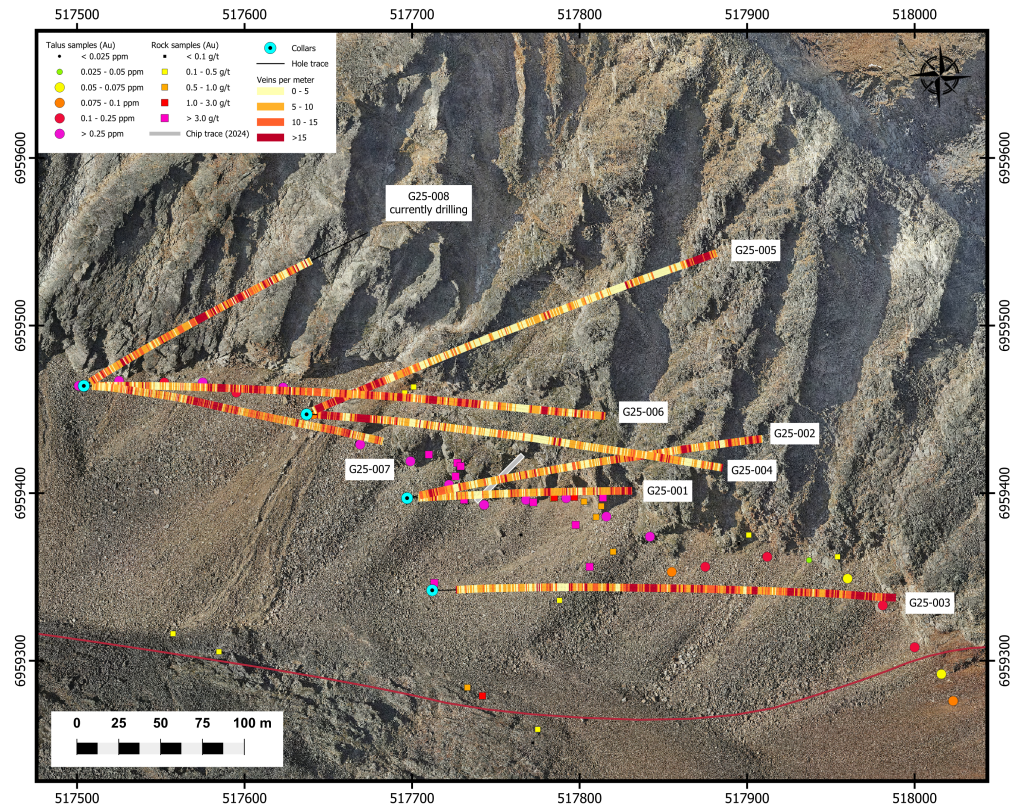
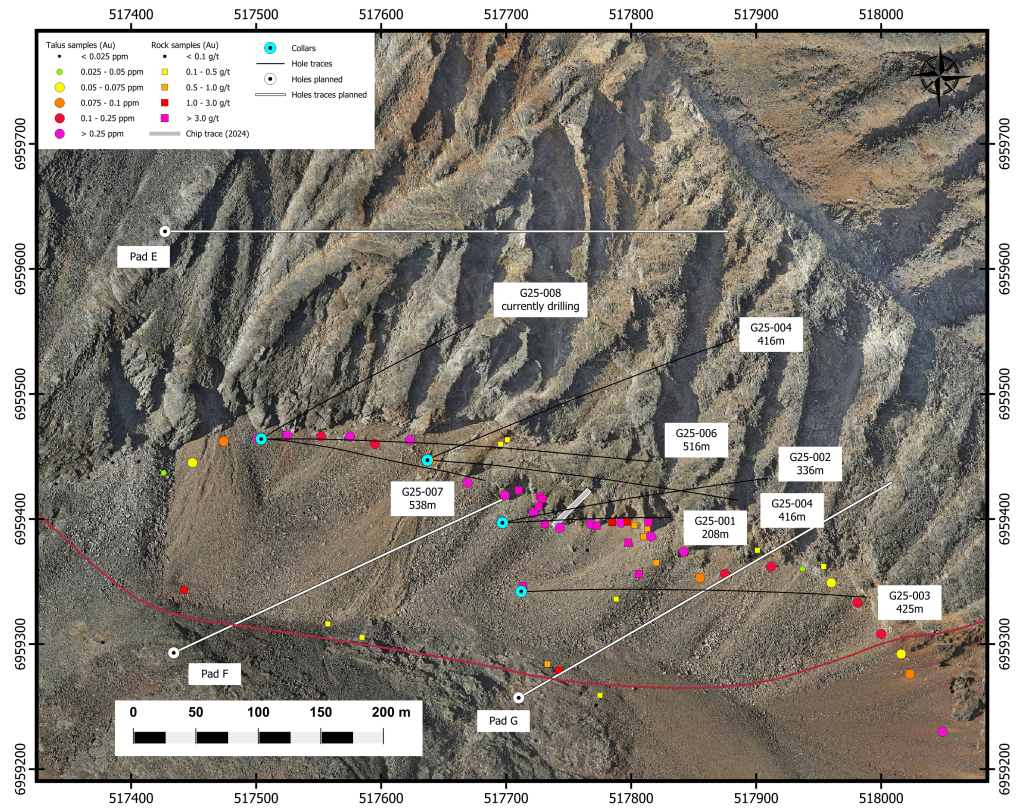
Photos





Core Photos
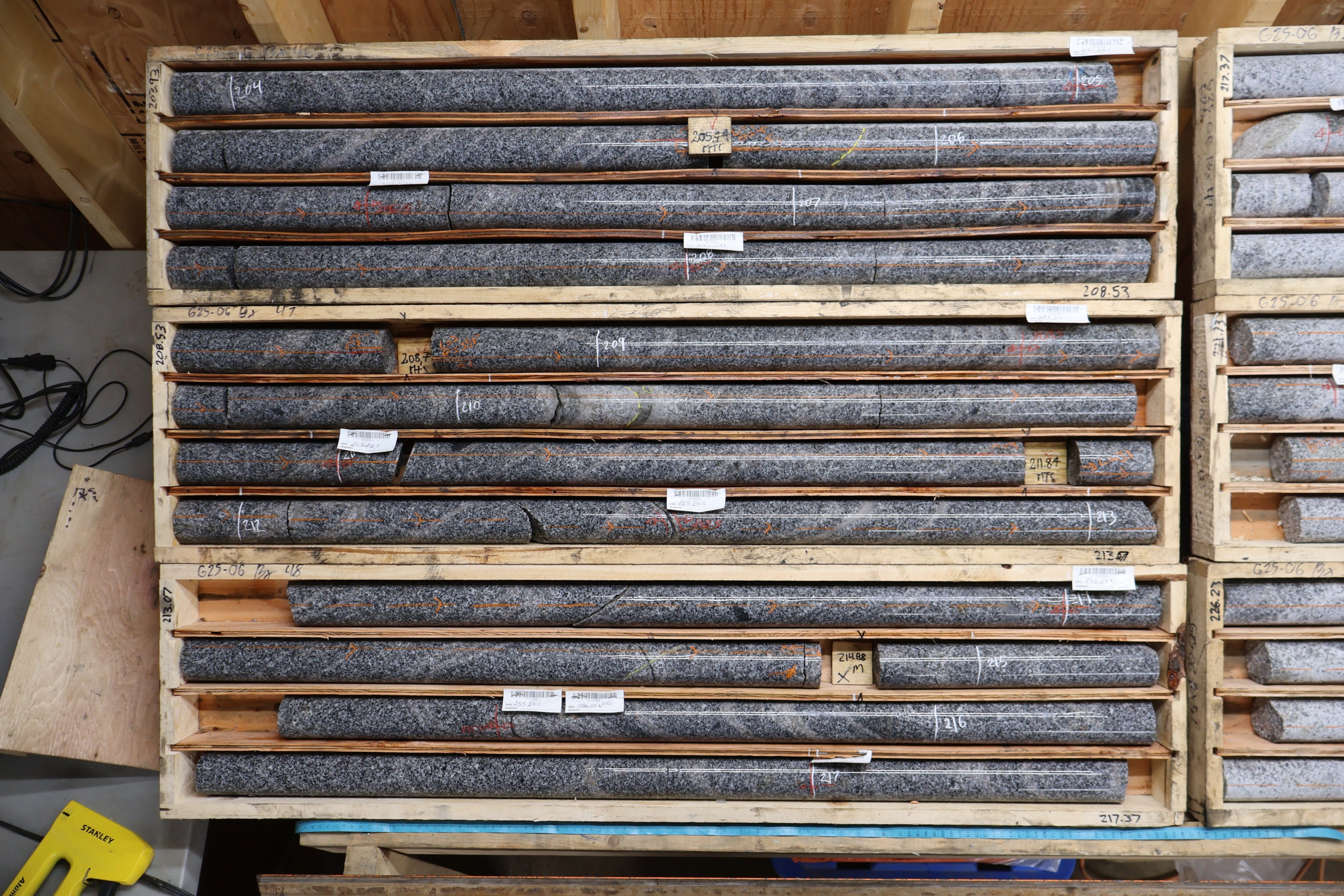
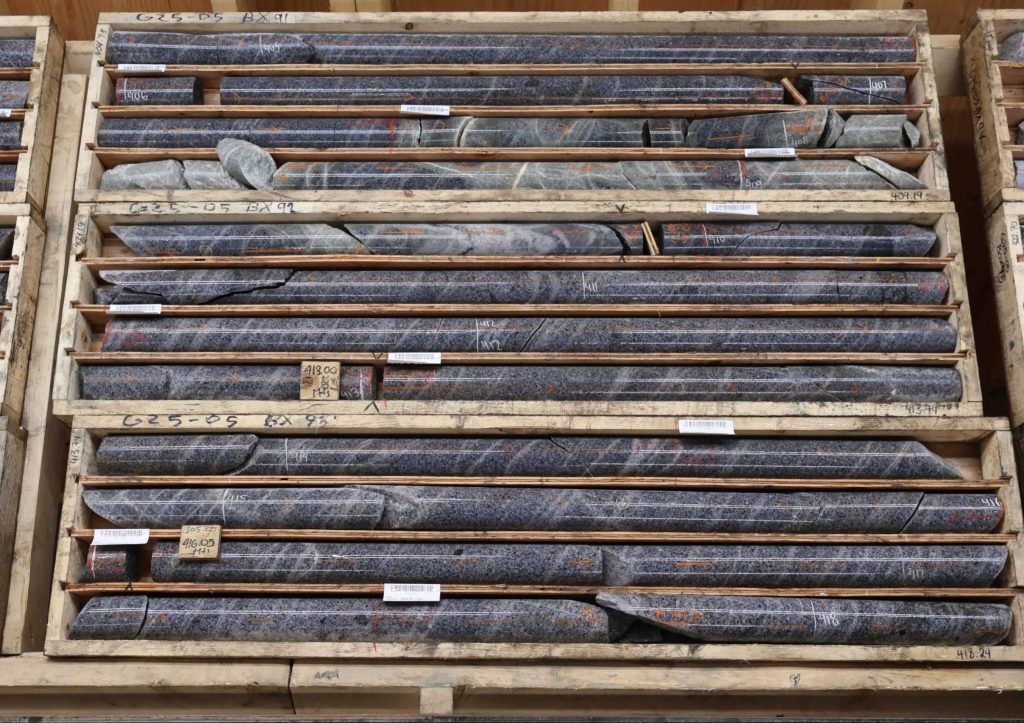
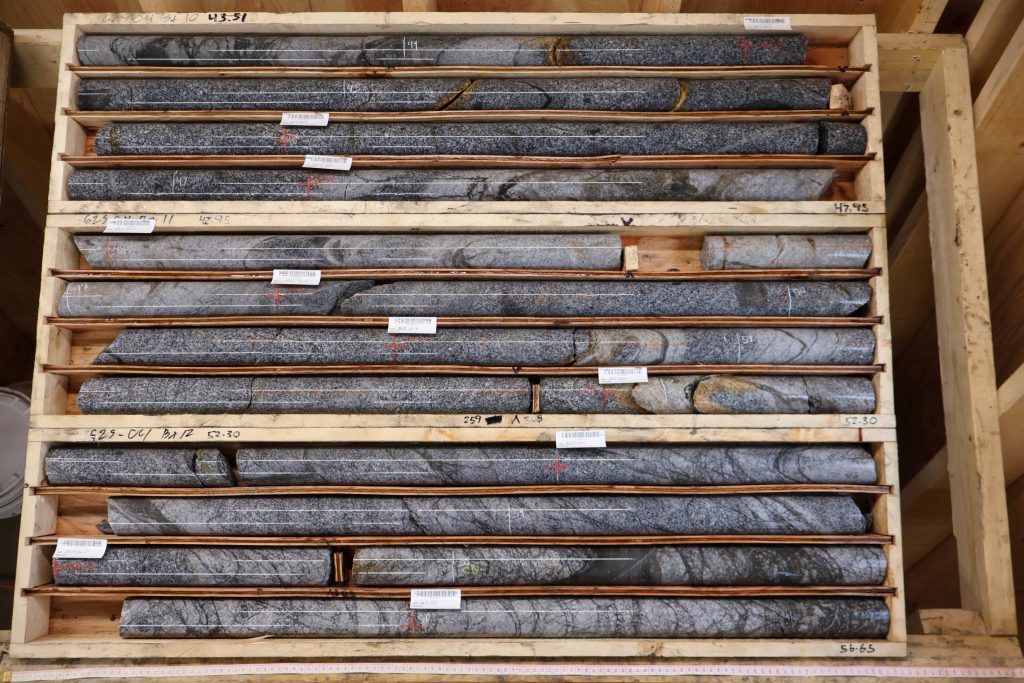
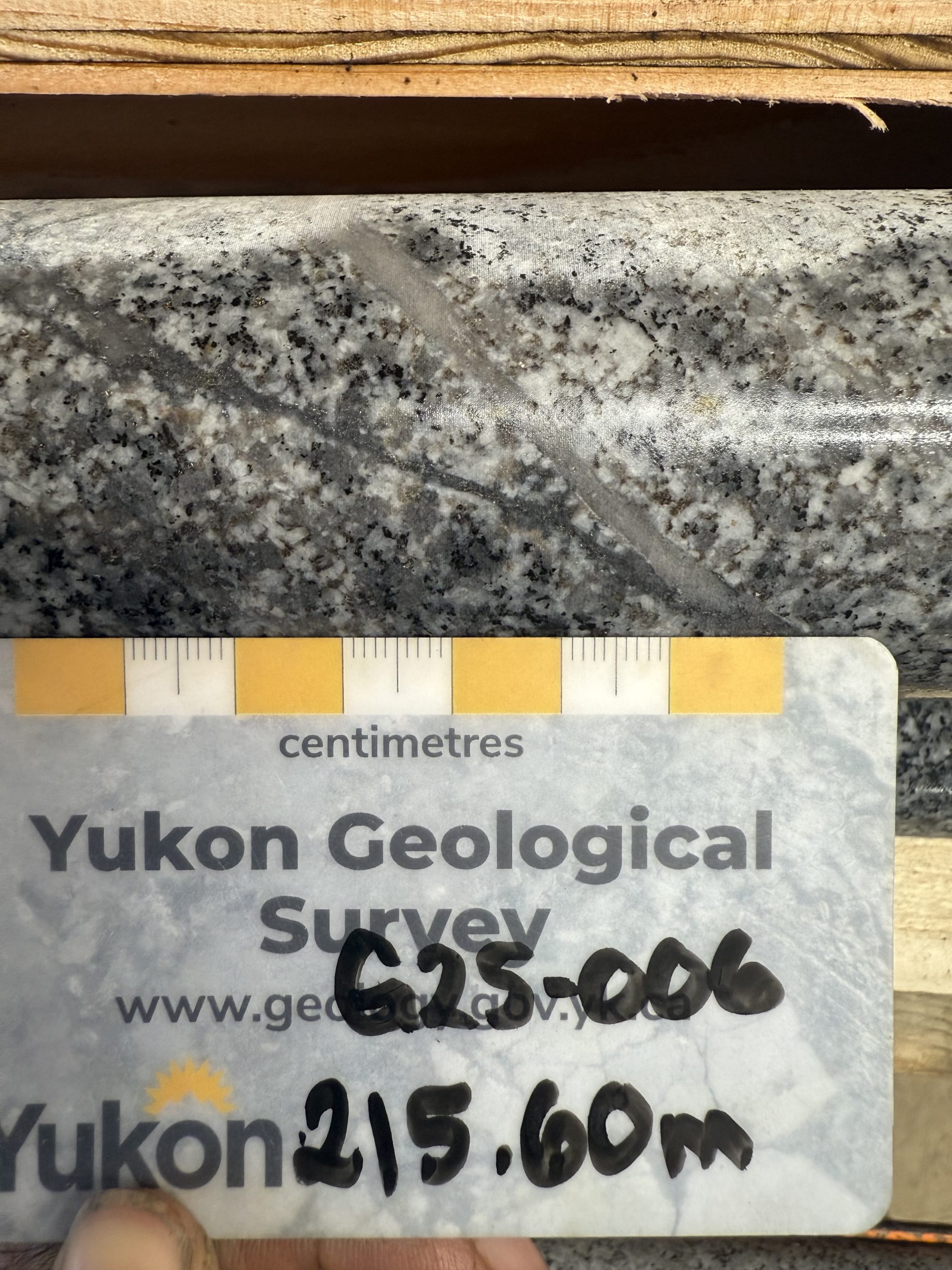
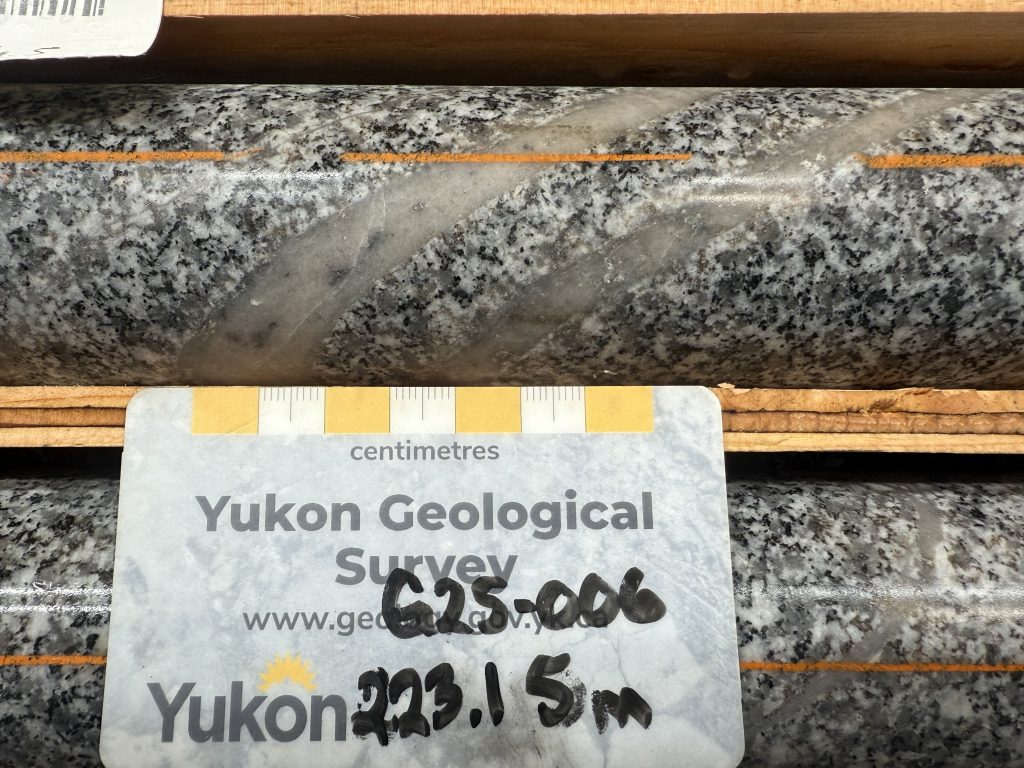
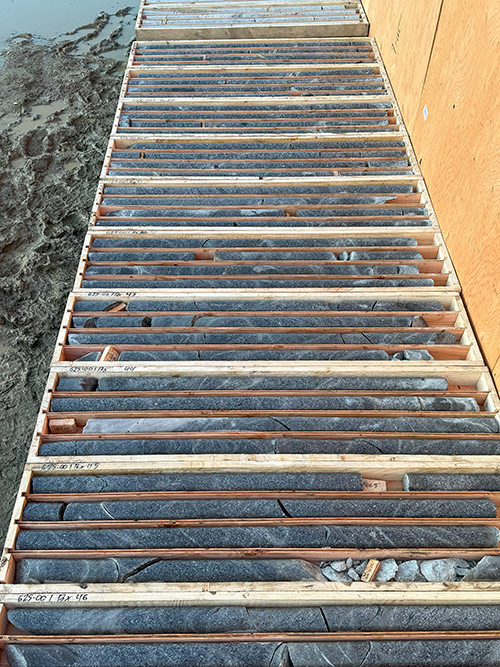

Coming Soon: Reports


